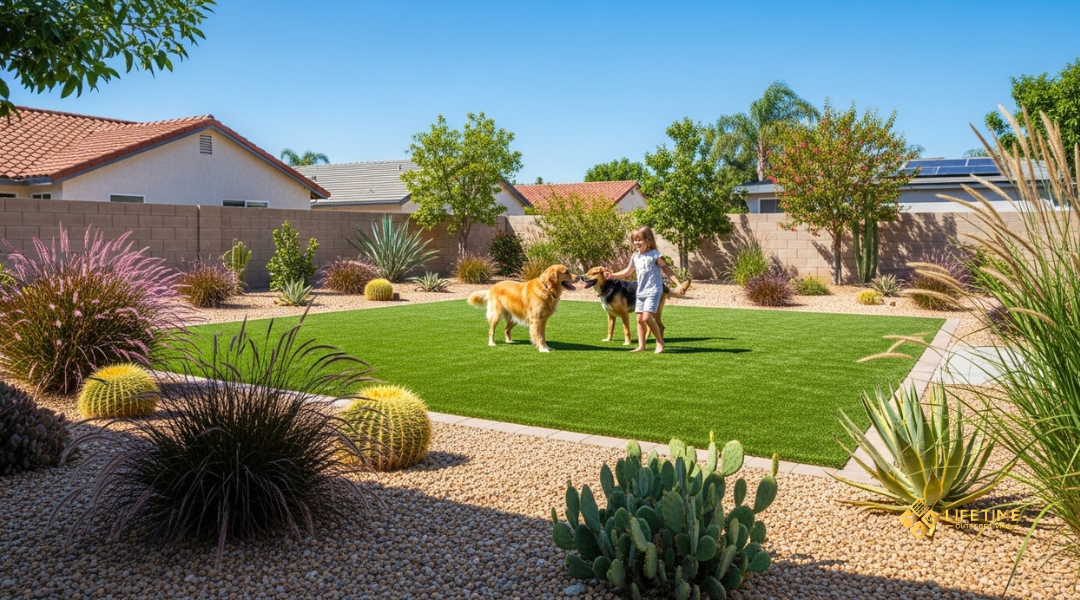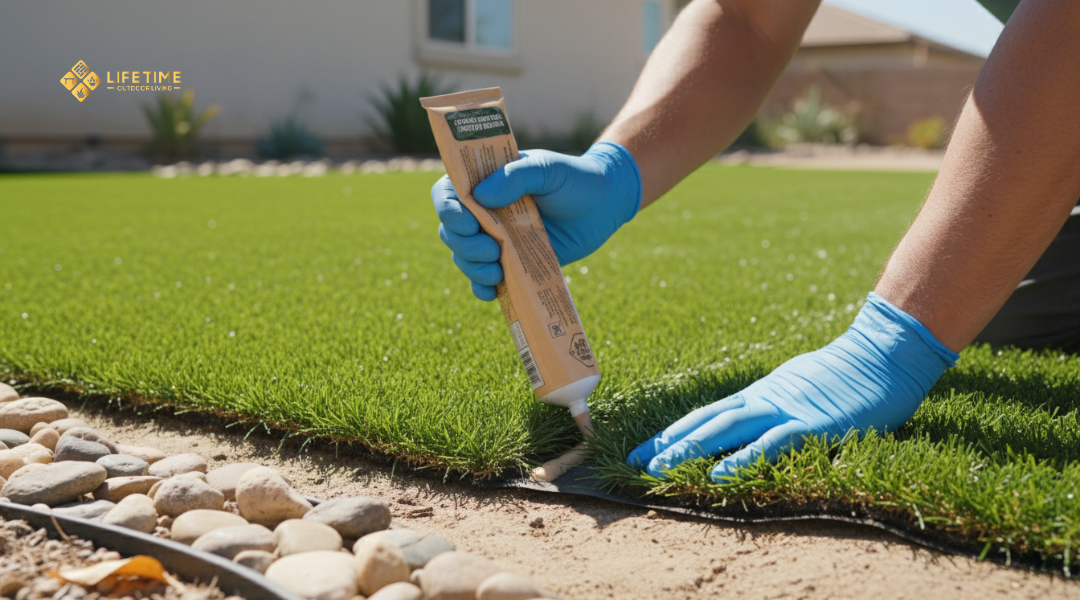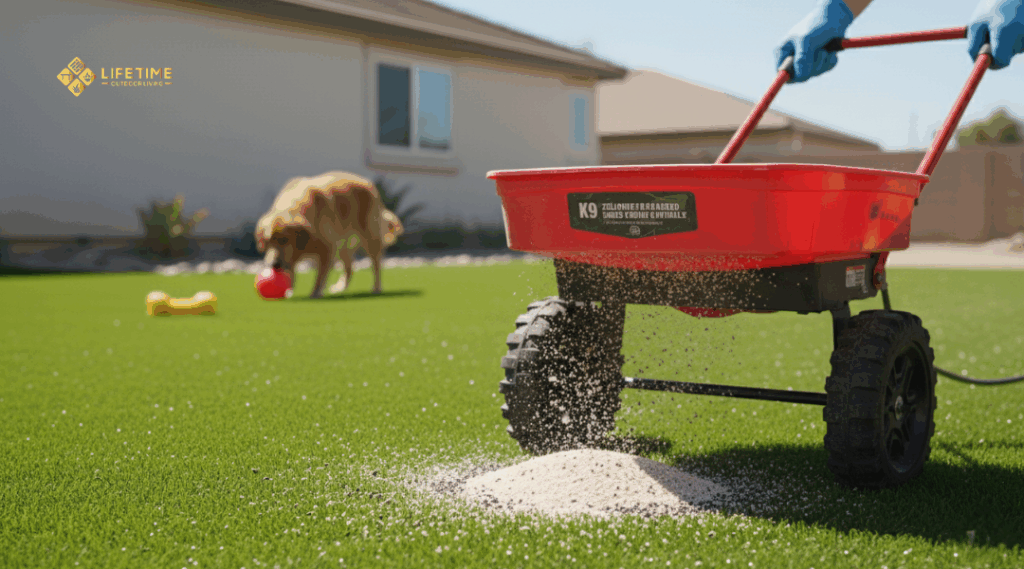Keeping turf fresh in Southern California takes more than an occasional rinse or quick brush. Between the region’s dry heat, hard water, and heavy foot traffic, your lawn faces unique challenges that demand consistent care. With the right turf maintenance routine, you can keep your outdoor space looking clean, vibrant, and ready for use year-round.
You’ll learn how to handle daily and monthly upkeep, manage dust and drainage, and spot early signs of wear before they become costly issues. Whether your lawn is synthetic or natural, understanding how to protect it from SoCal’s sun and soil conditions helps it stay soft, cool, and durable.
This guide walks you through everything from quick weekly tasks to deep cleaning and seasonal adjustments. By following these simple steps, you’ll spend less time fixing problems and more time enjoying a green, low-maintenance space that enhances your home’s outdoor living area.
What “Turf” Means In SoCal: Synthetic Vs Natural At A Glance
In Southern California, “turf” can mean either living grass or synthetic material designed to look and feel like it. Each type affects how much time, water, and money you spend to keep your yard looking clean and usable year-round.
Key Differences In Upkeep, Water, And Cost
Natural grass needs regular mowing, watering, fertilizing, and pest control. You also need tools or a professional service to maintain it. Synthetic turf only needs light cleaning, brushing, and occasional rinsing to remove dust or pet waste.
Water use is a major difference. A 1,000-square-foot natural lawn can use 600–1,200 gallons of water weekly during summer. Synthetic turf requires almost none, which matters in drought-prone areas.
Cost comparison (approximate for SoCal):
| Category | Natural Grass | Synthetic Turf |
|---|---|---|
| Installation | $1–$2 per sq. ft. | $8–$15 per sq. ft. |
| Annual Maintenance | $1,500–$4,000 | $200–$500 |
| Water Use | High | Minimal |
Over ten years, natural grass often costs two to three times more than synthetic turf when you include water and maintenance. However, real grass can stay cooler in hot weather and supports natural soil health.
When Synthetic Turf Makes Sense In Drought Zones
Synthetic turf fits well where water restrictions or high utility rates make irrigation costly. You avoid brown patches, weeds, and seasonal die-off. The surface stays green even during dry months.

If you have children or pets, quality turf handles heavy activity without turning muddy. It also drains quickly after rain.
For small or high-traffic yards, synthetic turf reduces upkeep while keeping a consistent appearance. You may spend more upfront, but you save time, water, and maintenance costs over the long term.
Daily And Weekly Basics: The 10-Minute Upkeep
Consistent, short maintenance keeps turf clean, odor-free, and evenly worn. You can prevent buildup, extend the turf’s lifespan, and maintain its appearance with a few quick habits that take less than ten minutes a day.
Quick Debris Removal And Light Rinse
Loose leaves, twigs, and dust can block drainage and flatten turf fibers. Use a leaf blower, plastic rake, or stiff broom to clear debris every few days. Avoid metal tools that may damage the turf backing.
For dust or pollen, give your lawn a light rinse with a garden hose once or twice a week. Focus on areas near trees, fences, or patios where debris collects.
If your turf sits under frequent shade or near sprinklers, check for damp spots. Allow those areas to dry fully after rinsing to prevent mildew. A quick visual check helps you catch issues early.
Pet Waste Protocol And Odor Prevention
Pick up solid waste as soon as possible to keep bacteria and odor under control. For liquid waste, rinse the area with water to dilute residues. A 50/50 mix of vinegar and water works well as a natural deodorizer.
Spray the solution, let it sit for a few minutes, then rinse again with plain water. Avoid harsh chemicals or bleach, which can discolor turf fibers.
If you have multiple pets, rotate their bathroom spots weekly. This prevents concentrated wear and reduces long-term odor buildup in one area.
| Task | Frequency | Tools Needed |
|---|---|---|
| Waste pickup | Daily | Waste bags |
| Rinse area | 2–3 times weekly | Hose |
| Odor treatment | Weekly | Vinegar mix spray |
Foot-Traffic Patterns To Watch
Heavy foot traffic compresses turf fibers and can create dull, flat paths. Watch for worn spots near gates, patios, or play areas. Brush fibers upright using a stiff broom or power brush to restore texture.
If certain routes see constant use, consider rotating furniture or adding stepping stones to redirect movement. This keeps wear even across the surface.
For high-use areas, brushing once a week keeps fibers upright and prevents matting. Regular light upkeep maintains both the look and function of your turf without major effort.
Monthly Care: Brushing, Infill, And Fiber Health
Regular turf maintenance keeps your artificial lawn looking natural and lasting longer. Focus on lifting matted blades, maintaining proper infill levels, and checking seams to prevent wear or damage.
Cross-Brushing To Lift Flattened Blades
Foot traffic and weather can press turf fibers down, making the surface look dull or uneven. Cross-brushing helps lift and separate the blades to restore their shape and improve the lawn’s appearance.
Use a brush or broom with synthetic bristles—never metal prongs—to avoid damaging the turf. Brush against the grain or in alternating directions to keep fibers upright and evenly distributed.
Perform this task once a month or more often in high-traffic areas. Brushing also helps remove small debris and keeps infill evenly spread, which supports the turf backing and improves drainage.
Checking And Topping Up Infill
Infill supports turf fibers, adds cushioning, and helps protect the backing from wear. Over time, rain and use can reduce infill levels, causing blades to flatten or seams to loosen.
Inspect infill depth every few months. If you notice thin spots or exposed backing, add new infill evenly across the surface. Use a drop spreader or your hands to distribute it, then brush it in to settle between fibers.
Choose infill suited for your needs:
| Type | Best For | Notes |
|---|---|---|
| Silica Sand | General use | Affordable and stable |
| Rubber or TPE | Softer feel | Good for play areas |
| Pet-safe infill | Homes with pets | Helps control odor |
Maintaining proper infill levels prevents matting and extends turf life.
Edge Inspection And Seam Checks
Edges and seams can loosen over time, especially in hot, dry climates like Southern California. Regular inspection helps you catch small issues before they become larger repairs.

Walk the perimeter and seams once a month. Look for lifting edges, gaps, or frayed joints. If you find loose spots, apply turf adhesive or re-secure with landscape nails or staples.
Keep debris and soil from building up along edges, as this can trap moisture and weaken the bonding. Consistent seam checks ensure your turf stays smooth, secure, and visually seamless throughout the year.
Deep Clean Quarterly: Odor, Stains, And Sanitizing
A quarterly deep clean keeps your turf free of odor, stains, and bacteria that build up from pets, spills, and weather. Regular sanitation and careful washing extend the life of your turf and keep it safe for family and pets.
Pet Enzyme Treatment And Bacteria Control
Pet waste can leave behind bacteria and lingering smells even after rinsing. Use an enzyme-based cleaner designed for synthetic turf to break down organic matter. These cleaners target proteins in pet urine and waste, eliminating odor at the source instead of masking it.
Apply the enzyme spray evenly across affected areas and let it sit for 10–15 minutes before rinsing. Focus on high-traffic or shaded spots where moisture can trap bacteria.
To reduce buildup, rinse weekly with a garden hose and disinfect monthly using a turf-safe sanitizer. Avoid bleach or harsh chemicals that can damage turf fibers or infill.
| Task | Frequency | Product Type |
|---|---|---|
| Rinse pet areas | Weekly | Water hose |
| Enzyme clean | Monthly | Turf enzyme spray |
| Sanitize | Quarterly | Turf-safe disinfectant |
Removing Spills, Gum, And Tough Stains
Accidents like drink spills, sticky gum, or oil can stain turf if not treated quickly. Start by blotting liquids with a paper towel or cloth—never rub, as it can spread the stain.
For sticky materials such as gum, harden the residue by applying ice for a few minutes, then gently scrape it off with a dull knife. Avoid metal tools that may cut the turf blades.
Use a mild soap-and-water mix for most stains. For oil or paint, apply a small amount of mineral spirits and rinse thoroughly. Always test cleaners on a small area first to ensure color stability.
Keeping a short cleaning kit nearby helps you respond quickly and prevent permanent marks.
Power-Rinse Vs Soft-Wash: When And How
A power-rinse uses moderate water pressure to flush out dust, pollen, and fine debris. This method works well for open areas and helps refresh flattened turf fibers. Use it once every few months to maintain drainage and appearance.
A soft-wash uses low pressure and a turf-safe detergent to sanitize surfaces without disturbing infill. Choose this method when treating pet zones or after heavy rain that leaves residue.
Avoid high-pressure washers, which can displace infill and weaken seams. Always rinse in the direction of the turf grain to prevent matting.
For best results:
- Power-rinse quarterly in dry seasons.
- Soft-wash after major cleanups or odor treatments.
- Inspect seams and infill afterward to confirm even distribution.
Drainage And Dust: Beating SoCal’s Dry Heat
Southern California lawns face two extremes—rare heavy rain that can flood low spots and long dry spells that kick up dust and debris. Managing both moisture and dryness helps protect your turf’s roots, keeps soil balanced, and prevents surface damage that weakens grass health over time.
Clearing Drains And Low Spots After Rare Heavy Rain
When rain finally arrives, it often comes fast and heavy. Poor drainage can leave puddles that suffocate roots and cause fungal growth. Start by checking that surface drains, gutters, and downspouts direct water away from your lawn. Clear leaves and debris before storms to keep water flowing freely.
Use a lawn aerator or garden fork to improve water absorption in compacted soil. Aeration helps oxygen reach roots and reduces standing water after storms. If you notice persistent low spots, fill them with a mix of topsoil and sand to even the surface and encourage better runoff.
For slopes or areas prone to pooling, consider installing French drains or gravel trenches. These systems redirect excess water underground, protecting your turf from erosion and root rot. Regular inspection after each rainfall ensures your drainage setup continues working properly.
Managing Dust, Pollen, And Ash From Winds
Dry winds in SoCal often carry fine dust, pollen, and wildfire ash that settle on your lawn. This layer can block sunlight and slow growth. Lightly rinse your turf with water in the early morning to wash away debris without wasting moisture through evaporation.
Keep nearby bare soil or pathways covered with mulch or gravel to limit dust movement. Mow regularly, but avoid cutting too short—slightly taller grass traps particles and shields soil from direct exposure.
If you live near wildfire-prone areas, check for ash buildup after wind events. Use a leaf blower on low power or a gentle spray nozzle to remove residue. Avoid raking dry ash, as it can become airborne and irritate your lungs.
UV Exposure And Heat Considerations
Prolonged sunlight and heat can stress turf and dry out topsoil quickly. Water deeply but less often—about 1½ to 2 inches per week—to encourage deep root growth. Early morning watering minimizes evaporation and heat stress.
Choose heat-tolerant grass types like Bermuda or St. Augustine for better resilience. Apply a slow-release fertilizer in spring or early summer to strengthen roots before peak heat arrives.
During extreme heat, raise your mower height to 3–4 inches. Taller grass shades the soil, reducing water loss and root temperature. Consider using organic mulch around borders to retain moisture and protect exposed soil from UV damage.
Weed And Pest Control Under And Around Turf
Managing weeds and pests around turf helps preserve its appearance, drainage, and lifespan. You can prevent most problems with good installation practices, consistent upkeep, and careful use of safe treatments.
Weed Barrier, Edging, And Joint-Line Maintenance
A weed barrier under synthetic turf blocks unwanted plant growth from pushing through the surface. Use a high-quality, permeable fabric that allows water to drain but resists root penetration. Overlap seams by at least 6 inches and secure them with landscape staples to prevent gaps.
Install solid edging—such as bender board, steel, or concrete curbing—around the perimeter. This keeps turf edges tight and stops weeds from creeping in from surrounding soil.
Inspect joint lines between turf panels every few months. If seams separate, brush infill back into place and rejoin the edges with turf adhesive or joining tape. Filling joints with silica sand or antimicrobial infill also discourages weed growth and stabilizes the surface.
Safe Herbicide Use Near Synthetic Turf
If weeds appear along borders or seams, apply herbicides carefully to avoid damaging the turf backing. Choose non-staining, water-based products labeled safe for synthetic surfaces. Avoid oil-based sprays, which can soften or discolor the turf fibers.
Use a spot-treatment method instead of broad spraying. Apply with a small hand sprayer or sponge applicator, targeting only visible weeds. Always follow the manufacturer’s instructions for dilution and timing.
Keep herbicide runoff away from drains and flowerbeds. After treatment, rinse nearby hardscapes with water to prevent residue buildup. For a low-impact option, use vinegar-based or citric acid weed killers that break down quickly and minimize environmental risk.
Ants, Gophers, And Deterrents
Pests like ants and gophers can undermine turf by creating tunnels that cause uneven surfaces. Before installation, compact the soil and lay down a wire mesh barrier to block burrowing animals.
For existing turf, treat ant mounds with boric acid bait or diatomaceous earth, which are effective and less toxic to pets. Avoid aerosol insecticides that can stain or degrade turf fibers.
If gopher activity appears, use underground traps or professional removal services rather than poisons. Maintaining clean turf edges and removing food sources, such as fallen fruit or pet food, helps deter repeat infestations.
Seasonal Playbook For SoCal
Southern California’s mild climate allows for year-round lawn use, but each season brings unique maintenance needs. Focus on keeping your turf clean, level, and well-drained to prevent wear, odors, and compaction caused by heat, wind, and seasonal storms.
Spring: Refresh Infill And Sanitize Before Peak Use
As temperatures rise, prepare your turf for heavier use. Start by brushing and loosening infill to restore even coverage and improve cushioning. Add more infill where you notice low spots or compacted areas. This helps maintain proper drainage and prevents matting.
Clean the surface with a turf-safe disinfectant to remove bacteria, pollen, and pet residues. Rinse thoroughly to avoid chemical buildup. Spring is also a good time to inspect seams and edges for lifting or fraying and repair them before they worsen.
If you have pets, use an enzyme-based deodorizer to control smells. Finish by checking irrigation or cooling systems to ensure water sprays evenly and drains properly. These steps keep your turf fresh and ready for summer activity.
Summer: Heat, UV Care, And High-Traffic Flattening
Summer brings strong sunlight and frequent use, which can flatten fibers and raise surface temperatures. Brush the turf weekly using a stiff nylon broom or power brush to lift blades and reduce compaction. This helps maintain a natural look and feel.
To manage heat, rinse the turf in the morning or late afternoon. Light watering cools the surface and removes dust. Avoid watering during peak sun to reduce evaporation. If your turf sees heavy foot traffic, rotate play zones or move furniture occasionally to prevent uneven wear.
Check for UV fading or melted spots near reflective surfaces like windows or metal fixtures. Use shade cloths or anti-glare film where needed. Keep infill levels consistent to support turf fibers and improve comfort underfoot.
Fall: Wind Debris And Ash Cleanup
Dry winds and wildfire season can leave fine dust and ash on turf surfaces. Use a leaf blower or soft rake to clear debris without damaging fibers. Avoid metal rakes that can tear seams or pull infill loose. Sweep or rinse ash promptly to prevent discoloration and odor.
After cleaning, inspect drainage lines and infill depth. Wind can shift material unevenly, leading to poor water flow. Top off infill where needed and brush it evenly across the surface.
If nearby fires cause heavy ashfall, use a mild detergent and turf-safe sanitizer to remove residue. Rinse thoroughly to protect turf fibers and backing from chemical buildup. Regular fall maintenance keeps your turf breathable and safe for use.
Winter: Storm-Prep And Post-Rain Drainage Checks
Winter storms in SoCal often bring short bursts of heavy rain. Before storms, check drainage grates, seams, and edges to ensure water flows freely. Clear leaves or soil that could block runoff. If your turf sits on a slope, confirm that water drains away from structures.
After rain, inspect for standing water or infill displacement. Use a broom to redistribute infill and lift matted fibers once the surface dries. Persistent puddles may signal clogged drains or compacted base layers that need attention.
Clean the turf with a gentle rinse to remove mud or organic debris. Avoid harsh cleaners that strip protective coatings. Keeping your turf free of buildup and ensuring proper drainage helps prevent odor, algae, and long-term damage during the cooler months.
High-Traffic And Pet Zones: Special Tactics
Areas that see constant use—like play lanes, putting greens, or pet runs—need extra attention to stay clean and durable. You’ll need to manage matting, control odors, and choose infill that supports both hygiene and comfort.
Matting Prevention In Play Lanes And Putting Areas
Foot traffic and rolling sports equipment can flatten turf fibers over time. To keep blades upright, brush your turf at least once a week using a stiff-bristled broom or a power brush. Work against the grain to lift fibers and redistribute infill evenly.
Inspect high-use zones for compacted spots. If you notice flattening, lightly rake the infill and add more where needed. This maintains cushioning and prevents uneven wear.
Try to rotate play areas or move portable goals and equipment occasionally. Small changes in use patterns reduce long-term compaction. For putting areas, use fine silica sand infill to maintain a smooth roll while supporting turf structure.
Extra Rinsing And Enzyme Schedule For Kennels
Pet zones collect more waste and bacteria than other areas. Rinse these surfaces two to three times per week with a hose fitted with a water-efficient nozzle. This removes dust, dander, and small debris without wasting water.
Use pet-safe enzymatic cleaners to break down urine and organic matter. Apply them on a weekly schedule or more often if you notice odor buildup. Always let the solution sit for a few minutes before rinsing to allow the enzymes to work effectively.
Keep a simple cleaning chart:
| Task | Frequency | Tools Needed |
|---|---|---|
| Rinse turf | 2–3 times weekly | Garden hose |
| Enzyme treatment | Weekly | Enzymatic cleaner, sprayer |
| Spot clean solids | As needed | Waste bag, mild soap |
Following this routine helps maintain freshness and prevents bacteria growth.
Odor-Absorbing Infill Choices
Infill plays a major role in odor control. Traditional rubber infill can trap smells, so switch to odor-absorbing materials like K9 sand or zeolite-based infill. These options are non-toxic, eco-friendly, and help neutralize ammonia from pet waste.

Spread the infill evenly using a drop spreader, then brush it into the turf to ensure full coverage. Check levels every few months and top off as needed.
Avoid infills containing microplastics or harsh chemicals. They can increase heat retention and make cleaning harder. Choosing the right infill not only reduces odors but also improves drainage and surface comfort for both pets and people.
Tools And Safe Products Checklist
Keeping your turf in top shape depends on using the right tools, safe cleaners, and proper storage. You need reliable equipment for upkeep, non-toxic products that won’t harm your lawn or pets, and safe handling habits that extend the life of your tools and materials.
Must-Have Tools (Brush, Broom, Blower, Hose)
You’ll need a few basic tools to keep your artificial or natural turf clean and even. A stiff-bristle brush helps lift flattened blades and remove debris. Use a wide push broom for larger areas to redistribute infill evenly.
A leaf blower quickly clears leaves, dust, and small debris without damaging the surface. Choose an electric or battery-powered blower for quieter, low-emission operation.
A garden hose with an adjustable spray nozzle helps rinse away dirt and pet waste. Avoid high-pressure settings that can displace infill or damage seams.
| Tool | Primary Use | Tip |
|---|---|---|
| Brush | Fluff turf fibers | Use synthetic bristles |
| Broom | Level infill | Sweep in alternating directions |
| Blower | Remove loose debris | Keep nozzle 6–12 inches above turf |
| Hose | Rinse surface | Use gentle spray mode |
Inspect tools often and clean them after use to prevent buildup.
Approved Cleaners And What To Avoid
Use mild, biodegradable cleaners for turf surfaces. A mix of warm water and a few drops of dish soap works well for most stains. For pet areas, use enzyme-based cleaners that break down odor-causing bacteria safely.
Avoid harsh chemicals like bleach, ammonia, or solvent-based products. These can discolor fibers and weaken the turf backing. Skip anything labeled “degreaser” or “acidic cleaner,” as these may strip protective coatings.
For natural lawns, use phosphate-free fertilizers and non-toxic weed control to protect local waterways. Always test new products on a small area first to check for color or texture changes.
Keep a small spray bottle of your approved cleaner ready for spot treatments so you can handle spills quickly.
Storage And Handling Safety
Store tools and cleaning supplies in a dry, shaded area away from direct sunlight. Heat and moisture can damage plastic handles, hoses, and cleaner containers.
Hang brooms and brushes to keep bristles straight. Coil hoses loosely and drain water before storage to prevent cracking. Keep blowers unplugged and batteries removed when not in use.
Label all cleaning products clearly and store them out of reach of children and pets. Use gloves when handling concentrated cleaners, and follow all directions on product labels.
Regularly check for leaks or corrosion in containers. Safe storage keeps your tools lasting longer and your maintenance routine efficient.
Troubleshooting: Fast Fixes For Common Issues
Proper turf upkeep helps prevent wear, drainage problems, and odor buildup. Paying attention to surface texture, seams, and moisture levels keeps your lawn safe, clean, and visually even.
Flattened Fibers And Shiny Spots
Heavy use or furniture pressure can flatten turf fibers, leaving shiny or matted areas. These spots make the surface look worn and can reduce drainage efficiency.
Use a stiff bristle broom or power brush to lift the fibers upright again. Brush against the grain to restore texture. For larger areas, lightly rinse with water to loosen compacted infill before brushing.
If fibers stay flat, check infill depth. Add ¼ to ½ inch of infill evenly across the area, then brush again. Routine brushing every few weeks helps prevent long-term matting, especially in high-traffic zones like patios or play areas.
Ripples, Seam Lift, And Edging Gaps
Temperature changes or poor installation can cause ripples or lifted seams. These irregularities create tripping hazards and let debris collect under the turf.
Inspect seams for separation or uneven tension. Apply turf adhesive or seam tape under the lifted area, press firmly, and weigh it down for several hours. For small gaps near edges, use landscape spikes or nails spaced about 6 inches apart to secure the border.
If ripples cover a large area, lift the turf carefully, stretch it flat, and re-anchor it while the surface is warm. Maintaining tight seams and smooth edges keeps the turf stable and visually consistent.
Persistent Odors Or Slow Drainage
Lingering odors often come from trapped moisture, pet waste, or organic buildup beneath the turf. Slow drainage usually points to clogged base layers or compacted infill.
Start by rinsing the turf thoroughly with a garden hose. Mix a mild vinegar and water solution (1:1) or a turf-safe enzyme cleaner to neutralize odors. Avoid bleach or harsh chemicals that can damage fibers.
If water pools after rinsing, check the base for compaction. Use a turf rake to loosen infill and improve airflow. In severe cases, remove and replace infill with a permeable silica sand blend to restore proper drainage and freshness.
When To Call A Pro Vs DIY
Maintaining turf in Southern California means balancing time, cost, and skill. Some upkeep tasks are simple enough to handle yourself, while others need professional tools and experience to keep your lawn in top shape.
Signs You Need Re-Seaming, Re-Infill, Or Repairs
Artificial turf seams can separate over time due to heat, foot traffic, or shifting ground. You’ll notice uneven edges, visible lines, or lifted sections. Loose seams allow debris and moisture underneath, which can shorten the turf’s lifespan.
If your infill looks uneven or compacted, the turf may feel flat or lose its cushioning. This often happens after heavy use or rainfall. Re-infill helps restore drainage, texture, and appearance.
Call a pro if you spot ripples, fraying edges, or drainage issues. These problems often need specialized adhesives, power brushes, or infill equipment that most homeowners don’t own. For small seams or light infill touch-ups, you can usually handle the work yourself using turf tape, sand infill, and a stiff broom.
Annual Pro Tune-Up: What’s Included
Professional turf maintenance once a year helps prevent wear and extend the surface’s life. A typical tune-up includes deep cleaning, power brushing, re-leveling infill, and inspecting seams or edges.
Technicians often use commercial vacuums to remove debris and pet waste that regular rinsing can’t reach. They also check for compacted areas, flattening, or odor buildup. In some cases, they treat the turf with antimicrobial or deodorizing solutions.
A pro service may also adjust infill depth to maintain even support and improve drainage. This keeps your turf looking upright and natural. While you can clean and brush your yard yourself, professional tools reach deeper layers, especially in high-traffic spots or shaded areas prone to mildew.
Cost And Time Estimates
DIY maintenance usually costs less but takes more time and effort. Expect to spend $50–$200 per year for supplies like infill, brushes, and cleaners. Small repairs may take a few hours on a weekend.
Professional tune-ups in Southern California often range from $300–$800 annually, depending on lawn size and service level. Larger or older installations may cost more if re-seaming or heavy cleaning is needed.
| Task Type | DIY Cost | Pro Cost | Time Needed |
|---|---|---|---|
| Light brushing & cleaning | $50–$100 | $150–$250 | 2–3 hrs |
| Re-infill | $100–$200 | $300–$500 | 3–5 hrs |
| Full tune-up | — | $500–$800 | Half day |
DIY saves money if you have the time and tools. Hiring a pro ensures consistent results and protects your turf investment.
Sustainability And Compliance In SoCal
Maintaining a healthy lawn in Southern California means balancing appearance with environmental responsibility. You must follow state and local rules on water use, choose safe products that protect soil and waterways, and plan for recycling or disposal of materials once they reach the end of their use.
Water-Use Rules And HOA Guidelines
Southern California’s dry climate makes water efficiency essential. Most cities restrict watering to certain days and times, often before 9 a.m. or after 6 p.m. to reduce evaporation. Smart irrigation controllers and drip systems help you stay within these limits while keeping your lawn healthy.
Many Homeowners Associations (HOAs) have adopted drought-tolerant landscaping standards. Some require native or low-water plants, while others limit turf area size. If you plan to replace grass, check local rebate programs such as LADWP’s Turf Replacement Rebate for financial support.
| Tip | Benefit |
|---|---|
| Install a weather-based timer | Reduces water waste |
| Use mulch around plants | Improves soil moisture |
| Repair leaks quickly | Prevents fines and saves water |
Following these rules helps you avoid penalties and supports the region’s long-term water goals.
Heat-Island, Runoff, And Eco-Friendly Cleaners
Urban areas in SoCal often trap heat, raising ground temperatures. Using light-colored or permeable materials for walkways and borders can reduce heat buildup. Planting shade trees around turf areas also lowers surface temperatures and protects grass from stress.
Runoff management is another key issue. When fertilizers or pesticides wash into drains, they pollute waterways. To prevent this, apply compost or organic fertilizers sparingly and water only enough to soak the soil.
Choose eco-friendly cleaners for tools and patios. Avoid bleach or ammonia-based products that can harm nearby plants. Biodegradable soap and warm water usually remove dirt effectively. These small steps help maintain both your lawn’s health and the local environment.
Recycling And End-Of-Life Considerations
Proper waste handling keeps your property compliant and sustainable. California law requires separating green waste, recyclables, and trash into designated bins. Yard trimmings, leaves, and food scraps should go into compost bins, not landfills.
If you replace turf, recycle old sod or artificial grass through city-approved facilities. Many municipalities, including Los Angeles and San Diego, partner with composting programs that turn organic waste into soil amendments.
For equipment, recycle batteries, oil, and metal parts through local hazardous waste centers. Avoid dumping old chemicals or fuel into drains. Responsible disposal keeps pollutants out of groundwater and supports California’s composting and recycling mandates under SB 1383.
Care Myths That Cost You Money
Many lawn care shortcuts sound helpful but actually waste money and damage turf. Misusing household cleaners or skipping regular upkeep can create long-term problems that cost more to fix than prevent.
“Bleach Fixes Odor” And Other Bad Advice
Bleach does not belong on grass or soil. It kills beneficial microbes and burns turf blades, leaving white or brown patches that take weeks to recover. Using bleach to remove pet odors or mold also harms nearby plants and can leach into groundwater.
Instead, use enzyme-based cleaners or diluted vinegar solutions designed for outdoor use. These break down organic matter without damaging grass.
| Unsafe Method | Better Option |
|---|---|
| Pouring bleach on odor spots | Enzyme cleaner or turf deodorizer |
| Spraying disinfectant on lawn | Rinsing and aerating the area |
Always test any product on a small patch first. A few extra minutes of care can save you from reseeding or replacing sod later.
“No Maintenance Needed” Vs Reality
Artificial turf and drought-tolerant lawns still need attention. Dust, pollen, and pet debris collect over time, reducing drainage and creating odors. Even natural grass in Southern California’s dry climate needs deep watering once or twice a week and periodic aeration to prevent soil compaction.
You should also brush synthetic turf fibers upright and rinse with water monthly to keep them clean. For natural lawns, remove thatch buildup and check irrigation heads for even coverage.
Skipping these steps can lead to flattened grass, drainage issues, and higher water use. Regular, light maintenance keeps your lawn fresh, saves money on repairs, and extends the life of both natural and synthetic turf.
Maintenance Log Template And CTA
Keeping track of your lawn care tasks helps you stay consistent and catch small issues before they grow. Using a simple log or checklist ensures your turf gets the right care at the right time, while knowing when to call a professional keeps your lawn in peak condition year-round.
Simple Monthly Checklist And Record-Keeping
A maintenance log helps you organize your turf care routine. You can use a printable or digital template to track mowing, watering, fertilizing, and aeration. Record each task’s date and any notes about weather, soil condition, or equipment used.
Example Monthly Log Table:
| Task | Frequency | Date Completed | Notes |
|---|---|---|---|
| Mow lawn | Weekly | ||
| Water deeply | 2x/week | ||
| Fertilize | Monthly | ||
| Inspect for pests | Monthly | ||
| Edge and trim | Every 2 weeks |
Keep your entries brief but consistent. This record helps you notice patterns—like dry spots or recurring weeds—and adjust your care plan. You can also share this log with a landscaper for better advice on turf health.
When To Schedule A Professional Turf Refresh
Even with regular care, your lawn will need professional attention at times. Schedule a turf refresh when you see thinning grass, compacted soil, or uneven color that doesn’t improve after routine maintenance.
Professionals can perform core aeration, topdressing, or overseeding to restore density and improve soil health. In Southern California, early spring or early fall are ideal times for these services due to mild temperatures.
If you manage synthetic turf, plan a professional deep clean once or twice a year. This removes dust, pet odors, and debris that regular rinsing can’t handle. Keeping a record of these visits ensures you maintain a healthy, clean, and long-lasting lawn.
Conclusion: Keep Your SoCal Turf Fresh Year-Round
Your artificial turf can stay clean and vibrant with regular care. The dry, sunny weather in Southern California makes maintenance simple but important. You don’t need much time—just a steady routine.
Simple steps for year-round care:
- Rinse weekly: Use a hose to remove dust, pollen, and pet waste.
- Brush fibers: Keep blades upright with a stiff broom to prevent matting.
- Spot clean: Use mild soap and water for spills or stains.
- Check drainage: Make sure water flows freely after rain.
| Season | Key Task | Frequency |
|---|---|---|
| Spring | Deep clean and brush | Monthly |
| Summer | Rinse often to cool turf | Weekly |
| Fall | Remove leaves and debris | Weekly |
| Winter | Inspect for wear | As needed |
You can also use a turf deodorizer or pet-friendly cleaner if you have animals. This helps control odor and bacteria without harming the turf.
Keep an eye on high-traffic areas. If you notice flattened spots, brush them more often to restore the look.
By staying consistent with these small tasks, you protect your investment and keep your yard looking neat through every season in SoCal.




